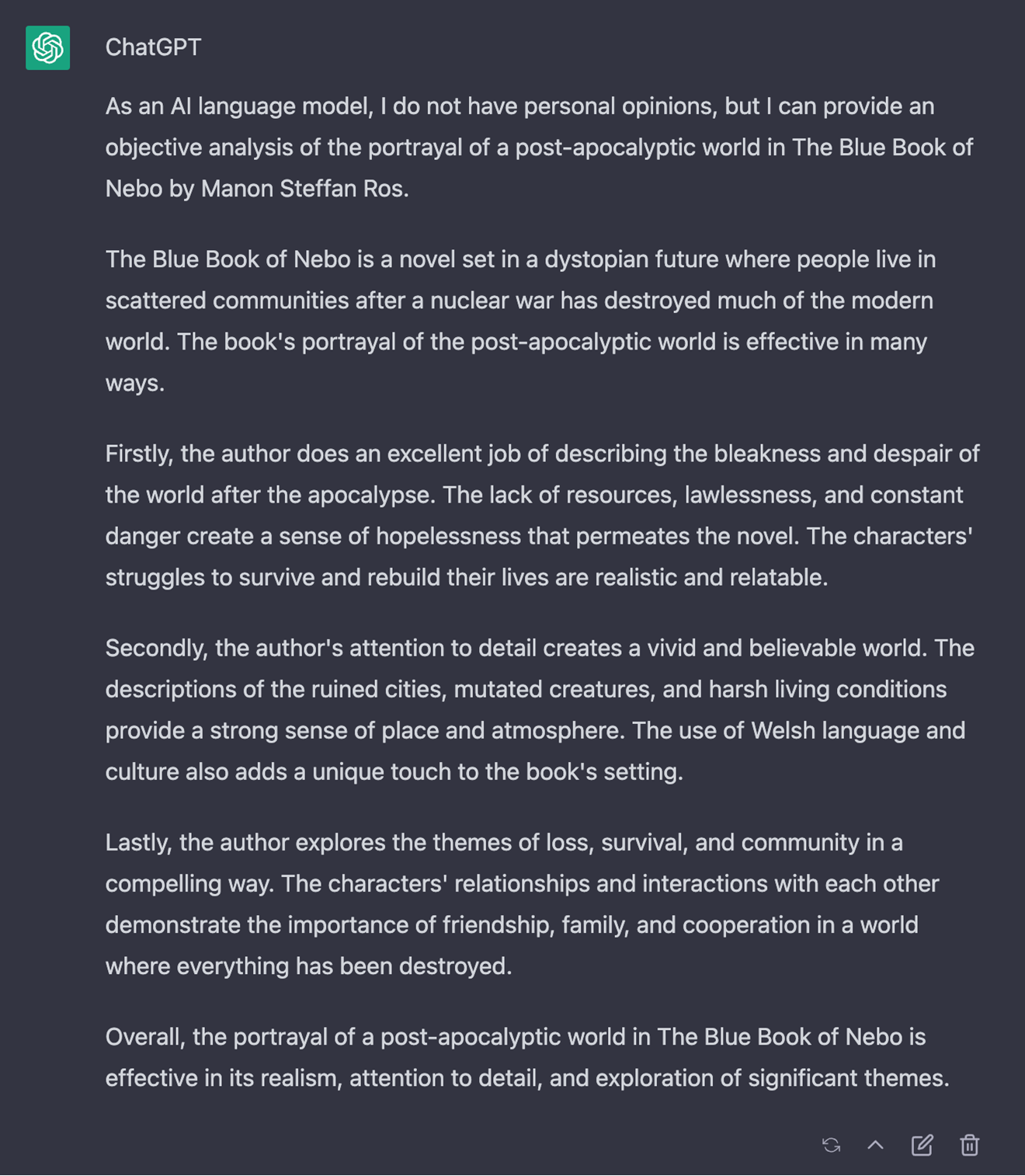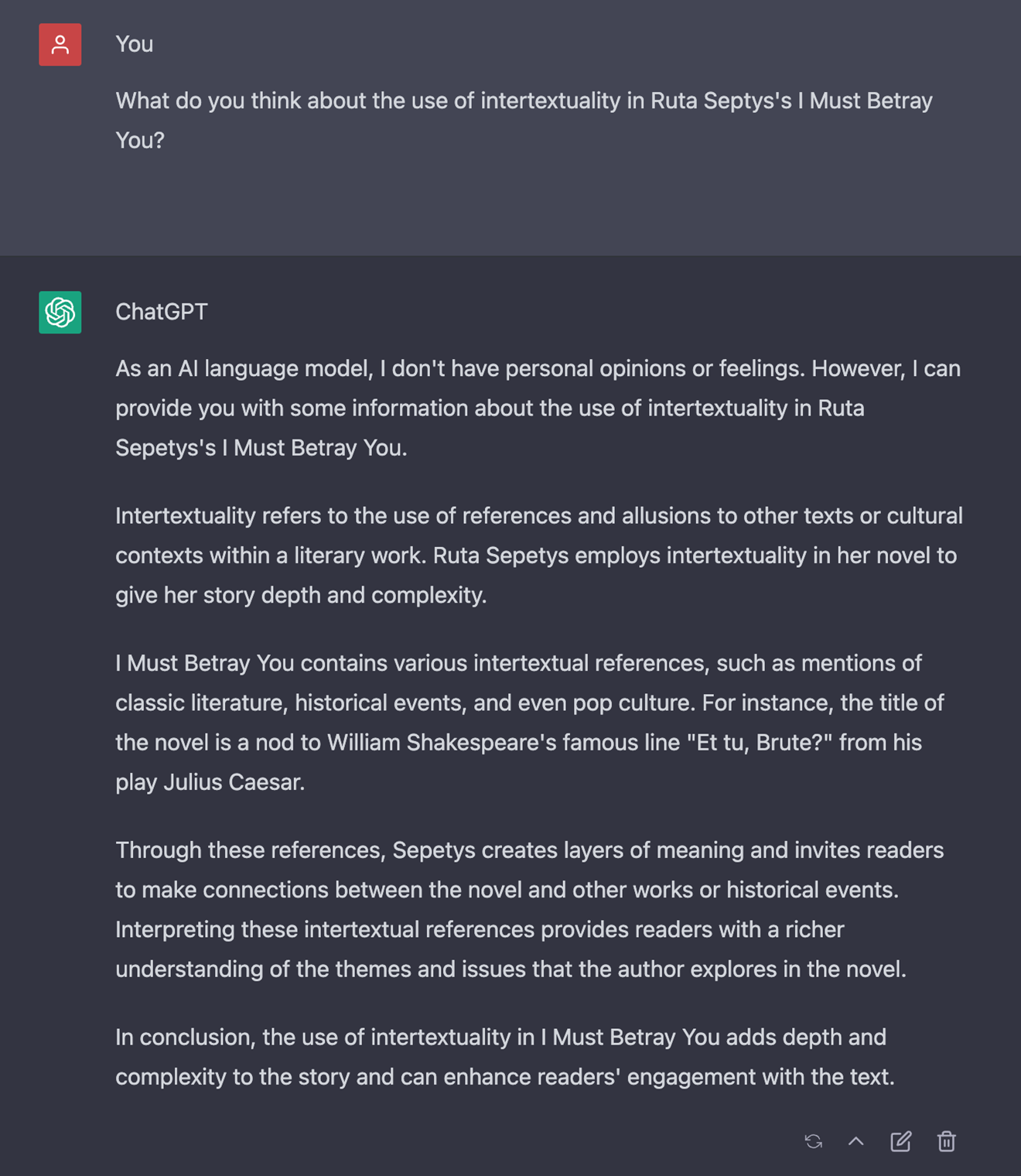Introduction
(With apologies to those who know a lot more about artificial intelligence than I do.)
Midst all the anxiety about chatbots taking over the world comes one interesting piece of news for English teachers: the most advanced chatbot can score fairly highly on standardised tests in pretty much all subject areas except for English Literature, where ‘it sits comfortably in the bottom half of the league table’ (1). We alone teach a subject that the most powerful artificial intelligence in the world cannot crack.
I’m sure your average chatbot, like any good student, will catch up soon. In the meantime, it’s worth pondering what it is about literary responses that currently make them resistant to replication by algorithms of mind-boggling sophistication.
The answer must lie somewhere in the nature of literature itself. It’s a medium designed to explore ambiguity and uncertainty. Even when a reader has come to the end of a text, meaning and understanding are never absolutely fixed. Computers don’t like ambiguity and uncertainty.
I’m basing my tentative thesis in part on a book by English educator, Judith Langer, called Envisioning Literature (2). She argues that literary study is vital for the development of young people because it provides them with a particular way of thinking, what she categorises as ‘literary thinking’. Literary thinking, she demonstrates in a number of studies, is best developed through dialogic interactions that encourage students to explore the ambiguity of texts, the different possibilities thrown up by literary reading material. Her studies draw strong links between developing literary thinking and levels of attainment (3) (4).
So the ambiguity and uncertainty at the heart of literary texts is matched by ambiguity and uncertainty in literary thinking and response. Langer constructs a powerful argument, one that stresses the importance of literary study as a vital intellectual tool. And if the most advanced chatbot cannot replicate this kind of thinking, then she must be on to something.
Over the past few weeks the EMC team has been writing resources for the Yoto Carnegies Medal for Writing. The shortlist has just been announced and I’ve been lucky enough to have read all seven contenders. It struck me as the perfect opportunity to explore my thoughts about the resistance of literary thinking to chatbot mastery. In reading all of the books I wanted to explore two ideas. One, that Langer’s argument holds good – that literature does develop particular ways of thinking in young people (and so make them think in ways as yet beyond the reach of a chatbot algorithm); two that literature written specifically for young readers is itself of a sophistication and complexity sufficient to develop these ways of thinking.
Here are some of my observations:
1. Reading is thinking
All reading is an unfolding process. So is thinking. Reading and thinking develop over time and, as processes, are never complete. Thinking is constantly being reframed in the light of new experience and knowledge. Even after a novel is finished, the way it is ‘read’ in your own head will change from day to day.
Good novels play on this unfolding process and the relationship between reading and thinking. Readers are fed enough information to make the experience of a book coherent and interesting, but not enough to make continuing pointless. Consequently, readers constantly have to engage their cognitive faculties, drawing on multiple processes: for example, predicting, questioning, adjusting, remembering, recapping, revising, evaluating, scrutinising and so on. They constantly have to think.
Needle, by Patrice Lawrence, is in many ways the most straightforward novel on the shortlist. As a Barrington Stoke publication, it is deliberately written to a reading age below the chronological age of its targeted readers. So it has a reading age of 8 but is aimed at a teen audience. The self-imposed restrictions on vocabulary and syntax, though, do not limit the thinking that goes on when reading this compelling, sophisticated portrayal of Charlene, a troubled girl, constantly moving between different foster families since the death of her mother.
Like many young people, Charlene finds herself in situations where saying sorry would make her life easier, even if she is more sinned against than sinner. In almost all situations she chooses not to apologise. The book demands readers think hard about the consequences of her choices: both to predict what they might be, but also to reflect on the outcomes when revealed. And of course, being literature, the consequences are never clear cut. Yes, this seemingly simple novel is highly resistant to chatbot logic.
2. Narrative as possibility thinking
Children’s and YA fiction plays with narrative possibilities more, I would say, than adult fiction. Staples of the genre, such as time-slip narratives, draw attention to the imaginative nature of storytelling – that it can literally take you anywhere in time and place. They force the mind to engage with alternatives in ways far beyond the everyday and so encourage thinking that challenges conventional boundaries. Louise Finch’s The Eternal Return of Clara Hart is the best example of this from the shortlist. At the end of the first section, a young woman dies. The whole novel then starts afresh in the second section, drawing on the ‘Groundhog Day’ trope. At the end, the young woman dies again. And so on and so on, ten times over. This novel has difficult, adult themes, written for an older YA audience. It tackles issues of sexual assault, drug taking and toxic masculinity. Lots of the thinking that goes along with reading this novel is focused on how it presents these issues themselves. But it is also a masterclass in narrative as a form of possibility thinking, each section starting in the same place, but ending somewhere different. Consequently, lots of the thinking is about how the writer does this, what it tells us about actions and consequences, what happens when we do things differently. Would a chatbot know how to respond with sophistication to a narrative (sequence of narratives) in such a state of flux?
3. Theory of mind – or understanding how other people think
Theory of mind is a term given to an aspect of cognition that psychologists identify as marking the difference between humans and other animals: unlike other animals, we are able to enter into the minds of our fellow beings, to imagine what they are thinking and feeling. If we are sensitive ‘readers’ of people and their reactions, or we know someone very well, we can often at least to some extent get this right. But we can never absolutely know someone else’s mind. There is always a gap in understanding. Good novels replicate this process. They let us enter into the thoughts of their characters, but not absolutely. That would be giving too much information, make empty and pointless the purpose of reading on to find out more. Sita Brahmachari’s When Shadows Fall is a superb example of a novel that stops just short of giving us too much information about its central protagonist, Kai, another troubled youngster who has suffered family loss. Written in multiple forms (e.g. notebooks, poems, journals, illustrations) and by different narrative voices (Kai himself, plus his friends Zak, Orla and Omid), everything is centred on Kai, but we can never be absolutely sure of his state of mind, or his intended actions. This extends to his friends as well as readers. Towards the end of the novel, Kai goes missing and readers and characters face an anxious wait to find out if he is all right. It’s a level of suspense and ambiguity that might wrongfoot the smartest of artificial intelligences.
4. Ironic juxtaposition
Novels can stimulate thinking by cleverly juxtaposing narrative elements side-by-side. Again, children’s and YA novels seem to do this more often than adult ones, certainly if we’re talking about creating parallel narratives that run alongside one another. Two of the shortlisted books do just this to brilliant effect in a process that we might call ‘ironic juxtaposition’ (a phrase I’ve borrowed from writing about picture-books and the tension that exists between text and image in the best examples.) In The Blue Book of Nebo, by Manon Steffan Ros, Rowenna and her son, Dylan, commit to recording their post-apocalyptic lives in the same notebook, but without ever reading what the other has written. Dylan recounts present day events; Rowenna records events leading up to and including the apocalyptic incident. As readers, then, we are privy to more information than the characters themselves. It makes for fascinating thinking about the nature of narrative, how events are retold within a particular context, how even people sharing their lives can tell them in different ways. Katya Balen’s The Light in Everything, for younger readers, uses a similar technique. Zofia and Tom are the respective children of divorced parents who get together. One is outgoing and physical, the other introverted and frail. In hearing both their perspectives, the reader pieces together a story bigger than each individual character. Effectively they get to think in multiples. How would Chat-GPT respond to this sophisticated representation of internalised thoughts?
5. Stories about stories
Novels don’t exist in our minds as isolated objects. They take their place alongside our other memories, be they drawn from the real world, or from other texts. Two of the novels in the shortlist expand on this process by offering their own interpretations of existing texts: one drawing on Greek myth, the other on actual historical events. Consequently, thinking focuses not just on the novel, but on previous versions of what they recount. Jessie Burton’s Medusa is a brilliant feminist rewrite of the Greek myth that requires deep thinking about who owns stories. Ruta Sepetys’s I Must Betray You imagines life in Romania in the final days of Communist rule from the perspective of 17-year-old Cristian. Responses to either are not just about the novel as read, but about the novel as interpretations of already existing stories. Perhaps it’s these layers of intertextuality that resist chatbot logic?
For me, this year’s shortlist is particularly strong. All of the novels really have got me thinking in literary mode: focusing not just on the content and how it is represented, but on the construction of the novels themselves, how they position me as a reader, how they build in ambiguity and uncertainty, how they resist straightforward interpretation. Importantly, they are also really satisfying reads. By turns, they are gripping, funny, provocative, stirring, challenging and – perhaps most of all – thought-provoking.
Who knows for how long high-quality literary responses can elude the forces of artificial intelligence. Probably not for very long, based on the recent astonishing advances in how it can handle and represent language. But the fact that literary thinking at the moment outsmarts AI thinking gives us pause for thought. It suggests that our subject offers young people something very special, something that we should continue to celebrate and promote in the face of an increasingly technocratic and functional world.
(This piece was not written by a chatbot.)
References
(1) Alex Hern (2023). 'What is GPT-4 and how does it differ from ChatGPT'. Accessed online at https://www.theguardian.com/technology/2023/mar/15/what-is-gpt-4-and-how-does-it-differ-from-chatgpt
(2) Langer, Judith (2011). Envisioning Literature: Literary Understanding and Literature Instruction. Columbia University, NY: Teachers' College Press
(3) Langer, J.A., 1998. 'Thinking and doing literature: An eight-year study'. The English Journal, 87(2), pp.16-23.
(4) Applebee, A.N., Langer, J.A., Nystrand, M. and Gamoran, A., 2003. 'Discussion-based approaches to developing understanding: Classroom instruction and student performance in middle and high school English'. American Educational research journal, 40(3), pp.685-730.
The Guardian has featured several excellent articles about ChatGPT. Here are three:
Alex Hern: What is GPT-4 and how does it differ from ChatGPT A handy introduction to the chatbot phenomenon
Kenan Malik: ChatGPT can tell jokes, even write articles. But only humans can detect its fluent bullshit This addresses directly how AI writing can help us reflect on how we teach writing to young people
James Bridle: The Stupidity of AI Long read that challenges urges caution over some of the hyperbole around chatbots
Appendix
By way of exemplification, we put a couple of questions to ChatGPT, relating to novels on the shortlist and reproduced below. As teachers, the responses will feel familiar. They are passable, but definitely ‘sit comfortably in the bottom half of the league table’. They’re formulaic and demonstrate basic factual recall rather than deep thinking (or any kind of thinking for that matter). I think it’s really illuminating to think about these responses in relation to what goes on in the classroom. How can we teach so that all students – not just the high-attainers – can move beyond this kind of response in order to demonstrate their own originality, personal thinking and critical judgement, no matter the attainment level they’re working at?






